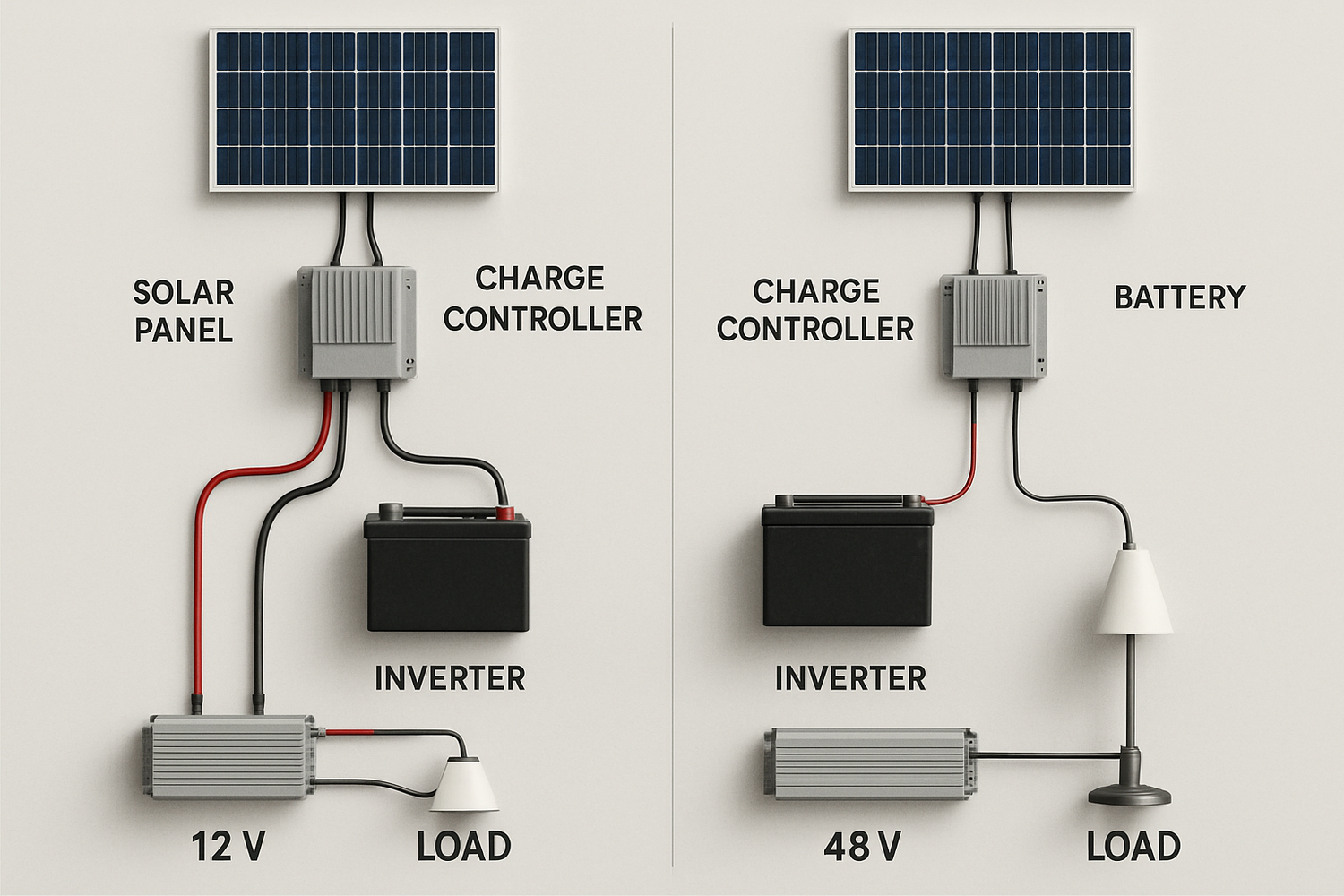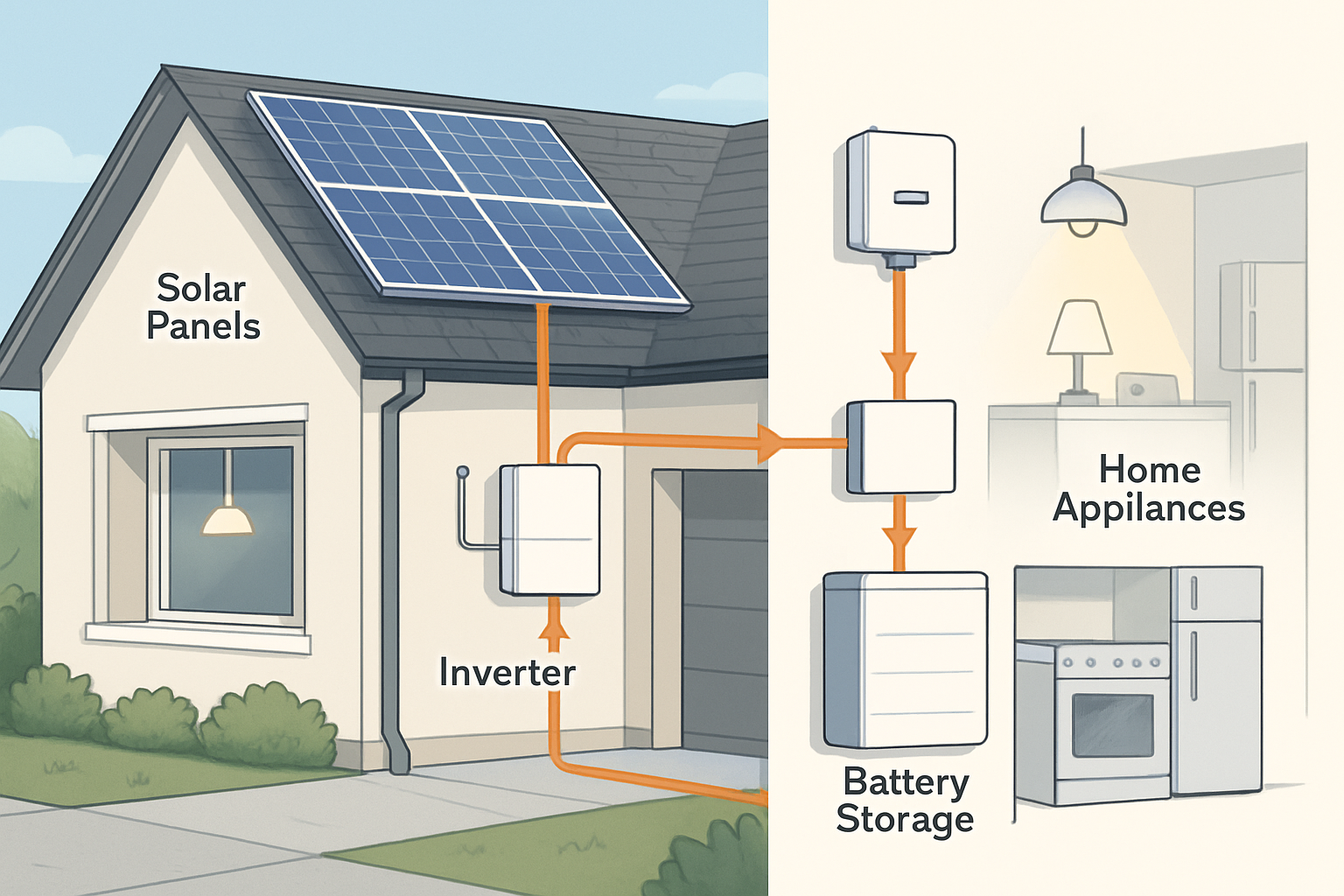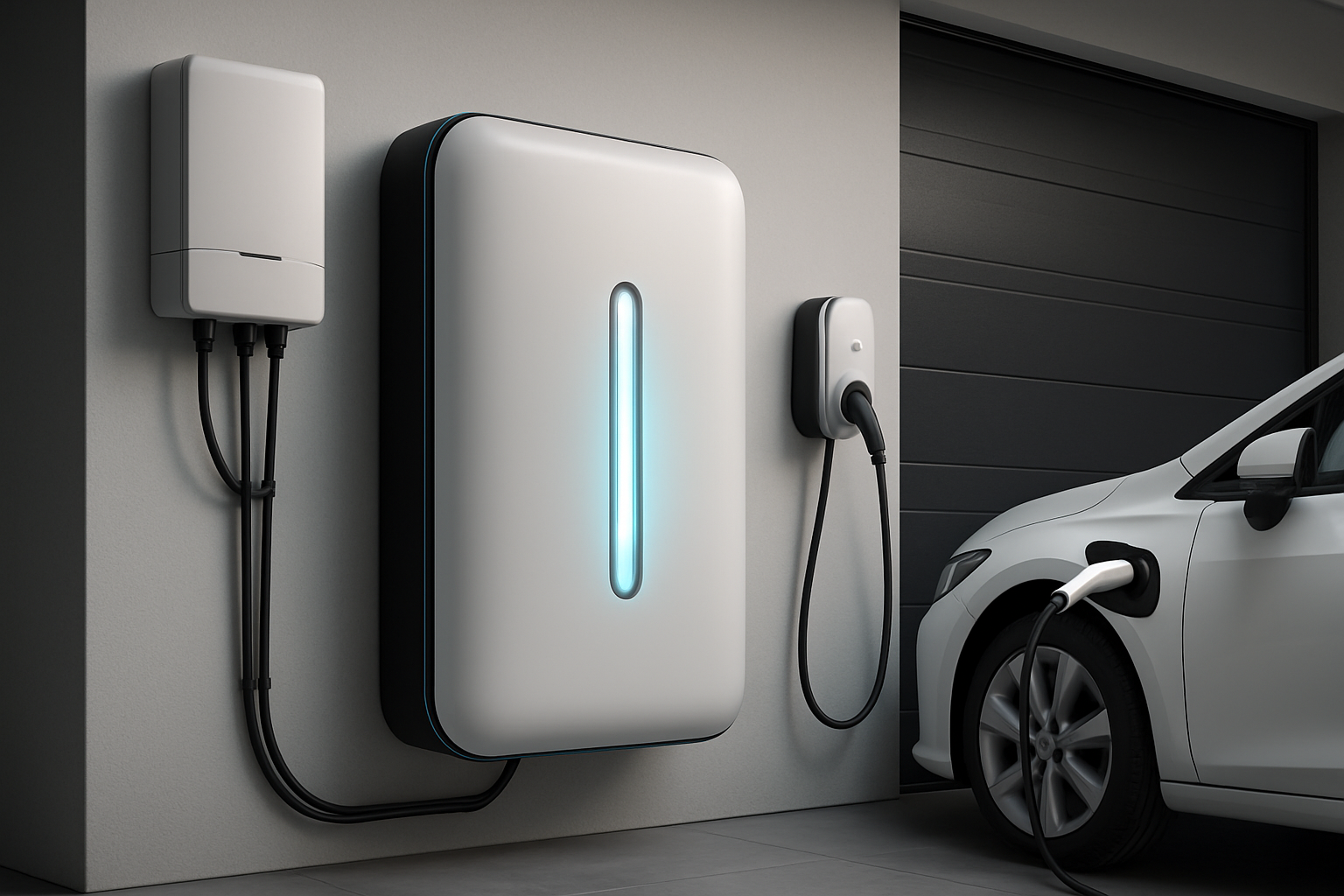Selecting the right battery is a critical step in designing a solar energy storage system. The system's voltage, specifically the choice between a 12V and a 48V LiFePO4 battery, fundamentally influences performance, cost, and efficiency. This decision affects everything from your cable thickness to the type of inverter you can use. Making an informed choice ensures your solar installation is safe, reliable, and optimized for your specific energy needs.
Understanding System Voltage Fundamentals
Before comparing 12V and 48V options, it's helpful to grasp the basic electrical principles at play. The relationship between voltage (V), current (A), and power (W) is described by the equation: Power = Voltage × Current. This means that to deliver the same amount of power, a lower voltage system must use a higher current, while a higher voltage system can operate with a lower current. This distinction is central to the differences between 12V and 48V systems.
The Role of LiFePO4 Chemistry
Lithium Iron Phosphate (LiFePO4) batteries have become a leading choice for solar storage due to their inherent safety, long cycle life, and stable performance. A single LiFePO4 cell has a nominal voltage of about 3.2V. Battery packs are created by connecting these cells in series to achieve the desired system voltage. For example, a 12V LiFePO4 battery typically consists of four cells in series (4 x 3.2V = 12.8V), while a 48V battery uses sixteen cells in series (16 x 3.2V = 51.2V).
The Case for 12V LiFePO4 Systems
12V systems have long been the standard for smaller, portable power applications. Their simplicity and the wide availability of compatible components make them an accessible entry point for many solar projects.
Applications and Advantages
12V LiFePO4 batteries are excellent for applications with modest power requirements. Think of RVs, boats, small off-grid cabins, and portable solar generators. The primary advantages include:
- Component Availability: A vast market of 12V-compatible appliances, inverters, and charge controllers exists, making it easy to find parts.
- Simplicity: For beginners, wiring a straightforward 12V system can be less intimidating than a higher-voltage setup.
- Cost-Effectiveness for Small Setups: For minimal power needs, the initial investment in a 12V battery and components can be lower.
Limitations and Considerations
The main drawback of a 12V system is its reliance on high current to deliver significant power. This leads to several limitations:
- Thicker, Costlier Cables: Higher current requires thicker and more expensive copper cables to operate safely and minimize voltage drop. For example, powering a 1200W load on a 12V system requires 100A, whereas a 48V system only needs 25A.
- Increased Energy Loss: High current leads to greater resistive heat loss in wiring (Power Loss = I²R). This makes 12V systems less efficient, especially over longer cable distances.
- Limited Scalability: Expanding a 12V system to meet growing power needs can be cumbersome and inefficient.
The Power of 48V LiFePO4 Systems
As solar installations become larger and more powerful, 48V systems are increasingly the preferred choice for residential and commercial applications. Their efficiency and scalability offer significant long-term benefits.
Applications and Advantages
48V LiFePO4 batteries are ideal for whole-home backup, off-grid homesteads, and any application with substantial energy demands. Their advantages directly address the limitations of 12V systems:
- Higher Efficiency: By operating at a lower current, 48V systems drastically reduce energy lost as heat in the wiring, leading to better overall efficiency.
- Thinner, Cheaper Wiring: The lower amperage allows for the use of smaller, less expensive cables, which simplifies installation and reduces material costs.
- Enhanced Scalability: 48V systems are designed for growth. It is much easier to add more solar panels and battery capacity to a 48V setup without major component overhauls.
- Powerful Inverter Compatibility: Most high-power inverters (3000W and above) are designed specifically for 48V battery banks, enabling you to run more demanding appliances simultaneously.
Limitations and Considerations
While powerful, 48V systems do have a few considerations:
- Higher Initial Component Cost: Some 48V components, like inverters and charge controllers, can have a higher upfront cost than their 12V counterparts, though this is often offset by savings on wiring.
- System Complexity: For those new to solar, the setup can seem more complex. However, integrated systems and clear guidelines have made this less of a barrier.
A Head-to-Head Comparison
Choosing the right voltage depends entirely on your application. The International Renewable Energy Agency (IRENA) notes that battery storage is crucial for integrating variable renewables like solar, and system design plays a key role in its effectiveness. Similarly, the International Energy Agency (IEA) highlights that falling battery costs are making solar-plus-storage systems increasingly competitive, underscoring the importance of efficient design. The table below summarizes the key differences to guide your decision.
| Feature | 12V LiFePO4 System | 48V LiFePO4 System |
|---|---|---|
| Ideal Application | Small, mobile systems (RVs, boats), portable power, low-power off-grid cabins. | Residential solar, home backup, large off-grid systems, commercial applications. |
| Efficiency | Lower, due to higher energy losses from high current. | Higher, with minimal energy loss in wiring. |
| Wiring (Size & Cost) | Requires thick, expensive cables to handle high amperage. | Uses thinner, more affordable cables due to lower current. |
| Component Cost | Lower upfront cost for individual components in small systems. | Higher upfront cost for some components, but wiring savings can offset this. |
| Scalability | Difficult to expand efficiently. | Excellent; designed for easy expansion of power and capacity. |
| Inverter Compatibility | Best for inverters under 2000W. | Required for most high-power inverters (3000W+). |
This table provides a high-level overview. For a detailed breakdown of key performance indicators that influence these factors, the Ultimate Reference for Solar Storage Performance offers comprehensive insights into charge efficiency and cycle life.
Making the Right Choice for Your Energy Needs
Ultimately, the decision between a 12V and 48V LiFePO4 battery storage system comes down to the scale and goals of your project. If your energy needs are small and portability is key, a 12V system remains a viable and straightforward option. However, for most stationary applications, including home energy storage and off-grid living, a 48V system is the superior long-term investment. Its higher efficiency, lower wiring costs, and greater scalability provide a more robust and future-proof foundation for achieving energy independence. As the U.S. Department of Energy's Solar Futures Study suggests, scaling up solar and storage is essential for a decarbonized grid, and efficient system architecture is key to that expansion.
Frequently Asked Questions
Can I mix 12V and 48V batteries?
No, you should not mix batteries of different voltages in the same battery bank. This creates a dangerous imbalance that can damage the batteries and poses a significant safety risk. All components in your system, from the battery bank to the charge controller and inverter, must operate at the same nominal voltage.
Is a 48V system more dangerous than a 12V system?
While 48V is a higher potential, it is still classified as extra-low voltage and is generally considered safe for handling with standard precautions. Any electrical system requires care and attention to safety protocols, such as using insulated tools and following installation manuals. The primary safety advantage of 48V systems is the lower current, which reduces the risk of overheating wires.
How does voltage affect the inverter I choose?
The inverter must be matched to the nominal voltage of your battery bank. A 12V battery bank requires a 12V inverter, and a 48V bank needs a 48V inverter. They are not interchangeable. High-power inverters designed to run multiple household appliances are almost exclusively available for 48V systems.
Can I upgrade my 12V system to 48V later?
Upgrading from 12V to 48V is a complete system overhaul. It requires replacing the batteries, the charge controller, and the inverter. Due to the significant cost and labor involved, it is far more practical and cost-effective to plan for your anticipated future energy needs and select the appropriate voltage from the start.





Leave a comment
All comments are moderated before being published.
This site is protected by hCaptcha and the hCaptcha Privacy Policy and Terms of Service apply.